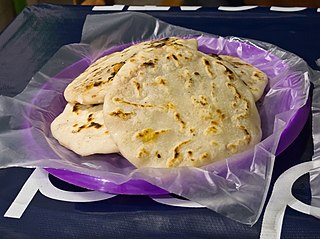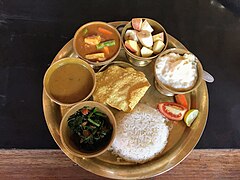
Chinese cuisine is an important part of Chinese culture, which includes cuisine originating from the diverse regions of China, as well as from Chinese people in other parts of the world. Because of the Chinese diaspora and historical power of the country, Chinese cuisine has influenced many other cuisines in Asia, with modifications made to cater to local palates. Chinese food staples such as rice, soy sauce, noodles, tea, and tofu, and utensils such as chopsticks and the wok, can now be found worldwide.
Portable soup was a kind of dehydrated food used in the 18th and 19th centuries. It was a precursor of meat extract and bouillon cubes, and of industrially dehydrated food. It is also known as pocket soup or veal glew. It is a cousin of the glace de viande of French cooking. It was long a staple of seamen and explorers, for it would keep for many months or even years. In this context, it was a filling and nutritious dish. Portable soup of less extended vintage was, according to the 1881 Household Cyclopedia,
"exceedingly convenient for private families, for by putting one of the cakes in a saucepan with about a quart of water, and a little salt, a basin of good broth may be made in a few minutes."

Miso soup is a traditional Japanese soup consisting of a stock called "dashi" into which softened miso paste is mixed. Many ingredients are added depending on regional and seasonal recipes, and personal preference.

Russian cuisine is a collection of the different cooking traditions of the Russian people. The cuisine is diverse, with Northern and Eastern European, Caucasian, Central Asian, Siberian, and East Asian influences. Russian cuisine derives its varied character from the vast and multi-ethnic expanse of Russia. Its foundations were laid by the peasant food of the rural population in an often harsh climate, with a combination of plentiful fish, pork, poultry, caviar, mushrooms, berries, and honey. Crops of rye, wheat, barley and millet provided the ingredients for a plethora of breads, pancakes, pies, cereals, beer and vodka. Soups and stews are centered on seasonal or storable produce, fish and meats. Such food remained the staple for the vast majority of Russians well into the 20th century. Soviet cuisine had a separate character of its own.

Stock is a flavored liquid preparation. It forms the basis of many dishes, particularly soups, stews and sauces. Making stocks involves simmering animal bones or meat, seafood, or vegetables in water or wine, adding mirepoix or other aromatics for more flavor.

Khmer cuisine or, more generally, Cambodian cuisine, is the traditional cuisine of the people of Cambodia. Average meals typically consist of more than one dish and ideally contrast flavours, textures and temperatures within the meal using plenty of herbs, leaves, pickled vegetables, dipping sauces, edible flowers and other garnishes and condiments.

Aspic is a dish in which ingredients are set into a gelatin made from a meat stock or consommé. Non-savory dishes, often made with commercial gelatin mixes without stock or consommé, are usually called jello salads in the United States or gelatin salads elsewhere.

Salvadoran cuisine is a style of cooking derived from the nation of El Salvador. The traditional cuisine consists of food from Native American cuisine, indigenous Lenca, Pipil and European Spanish peoples. Many of the dishes are made with maize (corn).

Banmian (板麵) is a popular Chinese noodle dish, consisting of handmade noodles served in soup.

Noodle soup refers to a variety of soups with noodles and other ingredients served in a light broth. Noodle soup is common dish across East and Southeast Asia. Various types of noodles are used, such as rice noodles, wheat noodles and egg noodles.
Amchoor or aamchur, also referred to as mango powder, is a fruity spice powder made from dried unripe green mangoes and is used as a citrusy seasoning. It is produced in India, and is used to flavor foods and add the nutritional benefits of mangoes when the fresh fruit is out of season.
Newa cuisine is a subset of Nepalese cuisine that has developed over centuries among the Newars of Kathmandu, Nepal. Newa cuisine is the most celebrated food variety in the country that consists of over 200 dishes. It is more elaborate than most Nepalese cuisines because the Kathmandu Valley has exceptionally fertile alluvial soil and enough wealthy households to make growing produce more profitable than cultivating rice and other staples.

Honduran cuisine is a fusion of indigenous (Lenca) cuisine, Spanish cuisine, Caribbean cuisine and African cuisine. There are also dishes from the Garifuna people. Coconut and coconut milk are featured in both sweet and savory dishes. Regional specialties include fried fish, tamales, carne asada and baleadas. Other popular dishes include meat roasted with chismol and carne asada, chicken with rice and corn, and fried fish with pickled onions and jalapeños. In the coastal areas and in the Bay Islands, seafood and some meats are prepared in many ways, some of which include coconut milk.

Nepalese cuisine comprises a variety of cuisines based upon ethnicity, soil and climate relating to Nepal's cultural diversity and geography.

West African cuisine encompasses a diverse range of foods that are split between its 16 countries. In West Africa, many families grow and raise their own food, and within each there is a division of labor. Indigenous foods consist of a number of plant species and animals, and are important to those whose lifestyle depends on farming and hunting.

Nigerian cuisine consists of dishes or food items from the hundreds of ethnic groups that comprise Nigeria. Like other West African cuisines, it uses spices and herbs with palm or groundnut oil to create deeply flavored sauces and soups. Nigerian feasts are colourful and lavish, while aromatic market and roadside snacks cooked on barbecues or fried in oil are plentiful and varied.
Belizean cuisine is an amalgamation of all ethnicities in the nation of Belize and their respectively wide variety of foods. Breakfast often consists of sides of bread, flour tortillas, or fry jacks that are often homemade and eaten with various cheeses. All are often accompanied with refried beans, cheeses, and various forms of eggs, etc. Inclusive is also cereal along with milk, coffee, or tea.

Soup is a primarily liquid food, generally served warm or hot, that is made by combining ingredients of meat or vegetables with stock, or water. Hot soups are additionally characterized by boiling solid ingredients in liquids in a pot until the flavors are extracted, forming a broth.













